According to research, up to 20% of women aged 25-40 years suffer from acne, and 87% of them have a condition called hyperandrogenism - a high level of production or activity of male sex hormones. Everything that happens on the skin is a consequence of the synthesis of sex steroid hormones, which exert their influence through specific receptors. Hormonal acne in women most often begins to appear due to estrogen deficiency and excessive androgen production. Therefore, both the diagnosis and treatment of acne in women and men differ, as well as the reasons for their appearance.
Why do acne appear due to hormone imbalance?
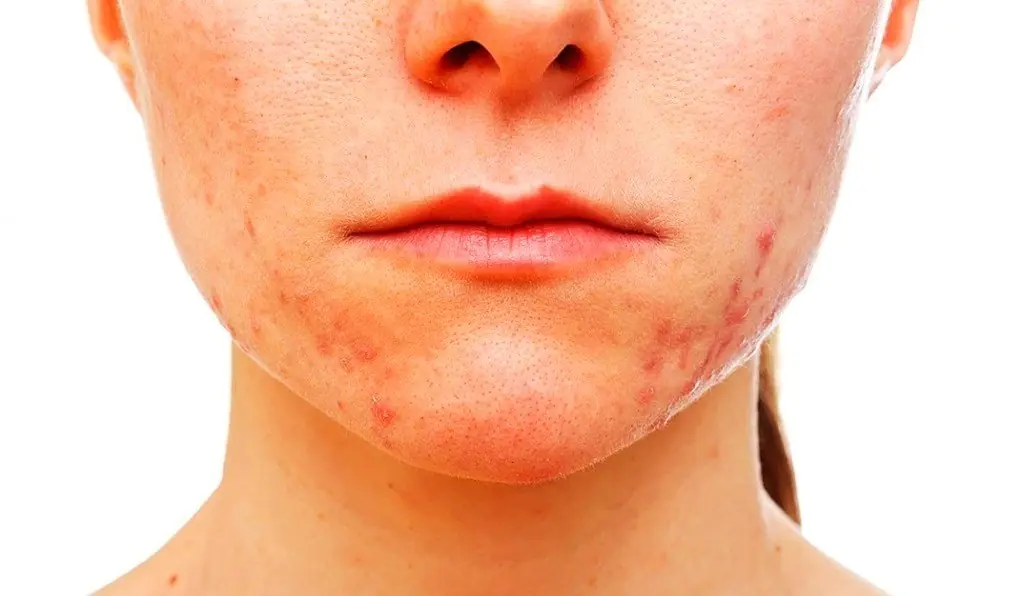
The skin is a target organ for steroids, so acne and hormones are closely related. Androgens can influence the size of the sebaceous glands and lead to disruption of their functioning, more precisely to hypersecretion. An increase in sebum production causes a change in its composition and a significant reduction in the amount of linoleic acid. Because of this process, follicular hyperkeratosis appears, in which skin cells begin to rapidly divide. Dead scales of the epidermis clog the ducts of the sebaceous glands that exit into the hair follicles. In this area, an environment is created that meets all the requirements for the active growth and reproduction of conditionally pathogenic microflora, including acne bacteria. As a result of their vital activity, acne appears.
What hormones cause acne
The ovaries, adrenal cortex, and subcutaneous fatty tissue (to a lesser extent) are responsible for the production of androgens in a woman’s body. Androgens are necessary for full development during puberty, but their excess in adulthood leads to global changes that affect appearance, reproductive health, metabolic processes and menstrual background.
The list of hormones that influence acne is as follows:
- testosterone;
- progesterone;
- dihydrotestosterone;
- prolactin.
Increased testosterone is a background factor contributing to the occurrence of female acne, while progesterone is responsible for how severe hormonal acne will be. Dihydrotestosterone is a more active testosterone that increases the number of receptors in the skin and the sensitivity of the sebaceous glands to them. It also stimulates the secretion of sebum and changes its properties. Prolactin is not a steroid hormone, however, it helps reduce estrogen production, which affects hormonal levels. Acne due to hormones has received various names: “postmenopausal”, “premenstrual”, “endocrine”, “late”, “hyperandrogenic”.
Hormonal acne on the face can appear due to dysfunction of the ovaries or adrenal cortex, and can be acquired or hereditary. The reasons that influence the appearance of acne can be both an increase in the level of androgens, and their normal amount, but capable of turning into more active forms or penetrating into target organs, one of which is the skin.
Polycystic ovary syndrome
Excessive androgen production and hormonal acne are more often a consequence of the disease polycystic ovary syndrome. Healthy ovaries produce two main hormones, estrogen and progesterone, and small amounts of androgens. The latter are necessary during pregnancy for the formation of a male fetus. The syndrome develops for many reasons, in particular during complicated pregnancy, head injuries, and endocrine disorders. In 70% of women, the disease is closely related to the pancreatic hormone insulin, which is responsible for regulating blood sugar levels. When there is too much insulin in the blood, the ovaries begin to actively produce androgens. Male hormones disrupt the functioning of the ovaries, which results in the formation of cysts. One of the external signs of polycystic disease is acne on the face.
How does prolactin affect acne?
Hormonal acne in women can be a consequence of increased levels of the hormone prolactin, which is responsible for the formation of mammary glands and milk production during breastfeeding. In addition, high levels of prolactin suppress the growth of follicle-stimulating hormone, without which estrogen cannot be produced. Prolactin is also a stimulator of androgen production. Insufficient concentration of estrogen and high growth of male hormones directly affect the appearance of acne.
Prolactin increases for the following reasons:
- frequent stress;
- strict diets;
- taking antidepressants and steroid drugs;
- kidney and liver disease;
- pathology of the pituitary gland, etc.
Even a slight imbalance between hormones associated with taking medications, steroids, or the menstrual cycle can cause the occurrence or recurrence of acne.
Signs of hormonal acne
Hormonal acne in women is localized mainly in the face and less often in the upper torso. They are comedones and inflammatory elements (papulopustular rash). Acne in women can be single, which is typical for a mild stage of the disease, or multiple in the form of red bumps and pustules.
The most severe form is conglobate acne in the form of nodules and cysts, after resolution of which deep scars remain.
Acne due to hormonal imbalance is often accompanied by other symptoms of hyperandrogenemia: seborrhea, menstrual irregularities, excess male-pattern hair growth on the face, abdomen, around the nipples and arms.
Diagnostics
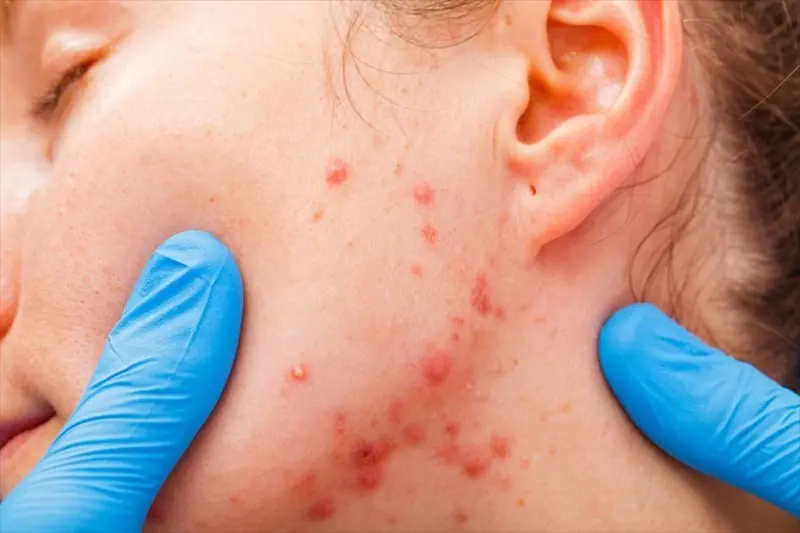
Before treating hormonal acne, a dermatologist, together with a gynecologist, examines the patient in order to identify the causes of the disease:
conducts a survey about the presence of gynecological diseases and the use of oral contraceptives; excludes diseases such as demodicosis, rosacea, perioral dermatitis; prescribes a biochemical blood test to identify the condition of the liver and kidneys; prescribes a laboratory study of the hormonal profile; reveals the nature of hyperandrogenemia (ovarian or adrenal).
It is possible that before treating acne due to hormonal imbalance, an ultrasound of the pelvic organs and an MRI of the adrenal glands will be necessary. In most cases, if hormonal acne is suspected, treatment will require consultation with a gynecologist and endocrinologist and appropriate examinations.
Acne therapy
When hormonal acne is diagnosed in women, treatment requires an individual approach. Both systemic and local medications are prescribed. Compliance with acne-toilet is a must, as this allows you to reduce treatment time, drug dosage and improve skin condition.
The general principle of how to deal with acne is aimed at reducing the level of male hormones, or stimulating estrogen and treating the disease that provoked hormonal imbalance.
Drugs are used that slow down the production of androgens in the adrenal glands and ovaries, block steroid receptors in the dermis, and suppress the process of converting testosterone into the more active form of dihydrotestosterone. For this purpose, combined oral contraceptives are prescribed.
Use of oral contraceptives
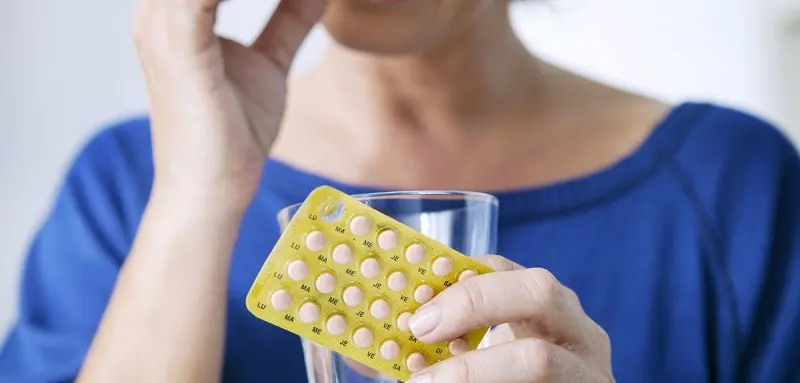
From a large list of drugs that are considered effective for treating hormonal acne in women, contraceptives based on ethinyl estradiol (estrogen), which reduces the level of androgen concentration in the blood, are isolated. As a result of taking medications, the secretion of the sebaceous glands is reduced and thus it is possible to cure hormonal acne.
However, in case of hormonal imbalance, therapy is mainly carried out with drugs based on drospirenone, dienogest, cyproterone acetate, desogestrel, the properties of which are similar to the female hormone progesterone. These are female gestagen hormones, which are produced in the body by the ovaries and slightly by the adrenal glands. They reduce the activity of androgens, prevent testosterone from being converted into active dihydrotestosterone, and reduce the sensitivity of androgen receptors in the skin.
Drospirenone
The 4th generation of combined contraceptives include drugs containing both ethinyl estradiol and drospirenone: Jess, Yarina, Midiana, Dimia. They not only eliminate acne, but also promote weight loss, so they are most suitable for women suffering from acne and prone to excess weight.
Midiana and Yarina are drugs with a low dosage of ethinyl estradiol. They are used according to the established scheme, 1 tablet for 21 days. The next course is after a week's break. The total duration of therapy is 6 months. During the treatment process, not only a significant reduction in acne is noted, but also that the skin becomes smoother, matte, its structure improves and the secretion of the sebaceous glands decreases.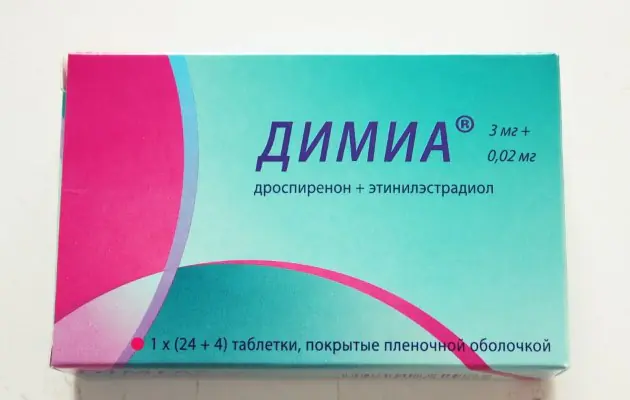
Preparations Jess and Dimia microdosed with ethinyl estradiol are used for 24 days, then a 4-day break.
Cyproterone acetate
Until now, the most effective drug used to combat hormonal acne, especially severe acne, is Diane-35, which combines ethinyl estradiol and cyproterone acetate. Analogues of Diana-35 are contraceptives Chloe and Belluna 35. All drugs belong to the 3rd generation of oral contraceptives. Cyproterone acetate is a substance with the most powerful antiandrogenic effect, but its use is limited and cannot last more than 6 months due to the high risk of side effects. After starting treatment, seborrhea and oily hair are noticeably reduced, and acne can be cured in 3-6 months. The drugs are used 1 tablet per day from the beginning of the menstrual cycle. The effectiveness of treatment can be judged after the first 3 months of use with mandatory monitoring based on test results.
Dienogest and desogestrel
Birth control pills based on dienogest (Janine, Siluet, Qlaira) are officially indicated for the treatment of acne. Siluet and Janine also contain ethinyl estradiol and are taken according to the standard regimen. Qlaira is several types of multi-colored tablets with different hormone contents, so the use of this contraceptive is multiphasic.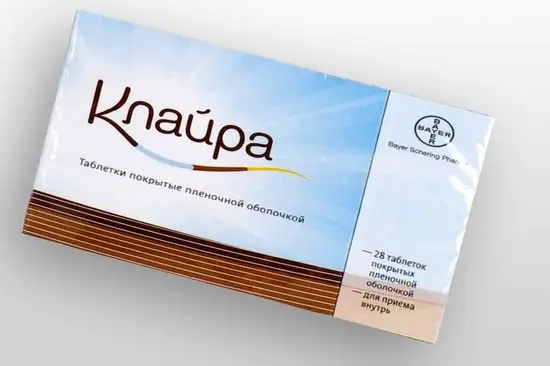
Using desogestrel-based contraceptives is another way to get rid of hormonal acne. These are drugs such as Regulon and Novinet. The reception scheme is classic.
Conclusion
Combined contraceptives only lead to a decrease in sebum production, so it is recommended to combine them with external agents based on azelaic acid, benzoyl peroxide, and antibiotics. These are drugs such as Baziron AS, Skinoren, Differin. Don't fight acne on your own. Only by comprehensively influencing all parts of the process of acne vulgaris can acne be treated effectively. Therefore, treatment is carried out by two doctors - a gynecologist and a dermatologist. The gynecologist prescribes drugs to normalize the ratio of hormone levels, the dermatologist prescribes local agents that affect hyperkeratosis and destroy bacteria. Only combination therapy allows for long-term remission and such good results in the treatment of acne that are difficult to achieve using any one method or remedy.
Hormones play an important role in the appearance and development of acne in women, and although the exact mechanism of action is unknown, androgens have been shown to act on the follicles and cause excess sebum production. Androgens are the so-called male hormones, but are normally present in both men and women. They are produced in the testicles (in men), ovaries (in women) and adrenal glands (in men and women). The most well-known androgens are testosterone and dihydrotestosterone, or DHT.
WHAT HORMONES AFFECT ACNE IN WOMEN
Research has shown that androgen receptors exist in the sebaceous glands and the cells lining the pores. If a woman has high levels of testosterone and dihydrotestosterone, they will in most cases affect these receptors. Simply put, these acne-causing hormones cause the skin to produce more oil, which will further feed the bacteria. Thus, by reducing androgens and testosterone, acne can be reduced.
In addition, the testosterone precursor hormone DHEA also influences the functioning of the sebaceous glands. DHEA sulfate levels begin to rise long before puberty, when the adrenal glands begin to produce it. At this time, acne begins to appear in adolescents who have a genetic predisposition to it.
Considering the above, when dealing with acne, women and girls first need to take hormone tests:
- testosterone,
- DHT (dihydrotestosterone),
- DHEA (dehydroepiandrosterone sulfate).
Additionally, the doctor may prescribe:
- androstenedione,
- cortisol
One of the factors that influence the increase in hormones is the food we consume. The typical diet for most people is high in saturated fat, processed grains, meat fats, refined sugars and low in fresh vegetables, fruits, fish, fiber, antioxidants and seaweed.
Healthy eating is one form of natural treatment for hormonal acne in women, not because acne comes from junk food, but because the quality of food can affect hormonal levels, especially during adolescence or if there are endocrine problems.
Another way to balance your hormone levels is to take certain vitamins and herbs.
ACNE IN WOMEN WITH HORMONAL DISORDERS
Very often, acne in women (especially after 30 or at a later age) appears due to hormonal imbalance, for example due to polycystic ovary syndrome. PCOS is a condition in which a woman has a hormone imbalance. Typically, in this case, there are low levels of estrogen and progesterone and high levels of androgens (male hormones that occur in small quantities in women). It is still not entirely clear what causes this violation.
Symptoms of PCOS include:
- absence or irregular menstrual cycle,
- cystic ovaries (on ultrasound),
- hair on the body, chest, face and around the nipples,
- thinning hair on the head,
- acne,
- dark spots on the skin around the neck, armpits, groin area or chest,
- reduction in breast size.
An increase in male androgen hormones is responsible for these “masculine” characteristics.
You can treat hormonal imbalance and acne using natural and natural methods: by changing your diet to one that will reduce androgens, taking herbs (for example, vitex) and other natural supplements. Although hormonal medications (mostly oral contraceptive pills) are perhaps the most popular way to combat PCOS and acne, they should only be used as prescribed by a doctor and in cases where gentler methods have not worked.
If you suspect that your acne on your face, chin, or chest may be caused by PCOS or another hormonal disorder, consult your doctor for testing and diagnosis.
HORMONAL ACNE IN WOMEN: NATURAL TREATMENT
- Take vitamins and herbs
Omega-3 fatty acids can lower testosterone in women and girls. Taking EPA and DHA supplements (such as quality fish oil) and adding more Omega 3s to your diet can help your body balance testosterone levels and eliminate acne.
Hormonal acne in women usually appears in the chin area. If you experience acne in this area during your period, chasteberry may help. Chasteberry is an herb also known as chasteberry and tree of Abraham that can be considered a folk remedy. It has been used with great success to treat women who have low progesterone in the luteal phase (the part of the cycle that begins after ovulation and ends the day before the next menstrual period) and high estrogen. Signs of low progesterone in women:
- depression,
- depression,
- mood swings,
- hormonal acne,
- nervousness and anxiety.
Symptoms of elevated estrogen include:
- breast pain and tenderness,
- bloating during menstruation.
Prutnyak acts on the pituitary gland and hypothalamus by increasing luteinizing hormone (LH) and slightly suppressing the release of follicle-stimulating hormone (FSH). This leads to a shift in the ratio of estrogen to progesterone, increasing the latter. Chasteberry's ability to increase progesterone is a side effect, as the herb itself is not a hormone. You can take it only after taking a test for the content of this hormone in the blood, in order to avoid an excessive increase in progesterone, which can, on the contrary, stimulate acne. Also, if LH levels are elevated, it is not advisable to drink Vitex.
The optimal time to take Vitex herb is in the morning between 7-8 o'clock, because at this time the pituitary gland and hypothalamus are active and regulate female sex hormones. To get the effect, you need to take prutnyak for about three months.
- Eat right
Studies have shown that when switching from a diet high in saturated fat to a diet with less fat and more polyunsaturated fat (nuts, fish, seaweed, green leafy vegetables) over six weeks, there was a significant decrease in androstenedione (a testosterone precursor). na) and testosterone in the blood. These studies have been conducted over many years, also studying the effect of fiber (grains, vegetables, beans) on a woman's hormonal levels. A high fiber diet has also been found to reduce blood levels of testosterone, DHT and DHEA.
The average daily fiber intake for the average person is approximately 13 grams. The recommended daily dose is 25 grams for women and 38 grams for men. Including fiber in your diet is beneficial for those who suffer from acne.
- Reduce your milk intake
DHT is able to bind to receptors in the sebaceous glands and “turn them on,” triggering acne and increased sebum production. Milk, in turn, increases DHT levels. Doctors have found that increased consumption of meat, protein foods, coffee, alcohol, sugar and processed grains worsens acne. On the contrary, it is beneficial to include fruits, vegetables and whole grains in your diet. Consuming too much meat, protein and milk leads to acidosis. The main symptom of acidosis is fatigue. Other symptoms include:
- loss of motivation,
- decreased libido,
- poor quality of sleep,
- depression and rapid mental and physical fatigue.
Additional symptoms of acidosis:
- sensitivity to cold,
- low blood pressure,
- hypo- or hyperthyroidism,
- low blood sugar.
These symptoms are caused by the fact that the body uses essential minerals that are needed to nourish the nervous system, such as calcium, magnesium and potassium, to neutralize acids. Stress also causes increased acidity in the body, which has been proven by studies. Alkaline foods (vegetables, fruits, honey, nuts, green tea) neutralize these acids and reduce levels of cortisol, the stress hormone (which is most often elevated in women with hormonal acne).
- Reduce stress
Stress does affect hormones, and in the modern world we are exposed to it all the time, starting in kindergarten and even earlier. You should try to reduce its exposure, as it causes damage to the body and nervous system. Cortisol, a stress hormone, has been found to increase in patients with acne. Additionally, an acid-forming diet (animal meats and processed grains) has been found to increase cortisol. A 2003 study found that increasing the amount of alkaline foods in the diet, such as fresh vegetables and fruits, decreased cortisol levels in the body. In addition, the person begins to feel better physically and mentally; Decreasing cortisol levels also reduces inflammation and may be a factor in the healing of inflammatory hormonal acne and pimples.
When adolescence is over, but there are no rashes on your face, there is reason to worry. Everyone who has encountered this has thought: “What if there is simply no gap between pimples and the first deep wrinkles?”
piedradealumbre.org
If, in the fight for healthy skin, you have already tried all the mass market products that promise to solve the problem in 15 minutes, poured heavy artillery on yourself in the form of expensive pharmaceutical cosmetics, and even went to the dermatologist, who still did not help you - this text is for you .
We asked the gynecologist five main questions about how hormones affect the condition of our skin.
Obstetrician-gynecologist of the first qualification category at the Eva Women's Health Clinic, clinical resident at the Department of Obstetrics and Gynecology of BelMAPO
How do the phases of the menstrual cycle affect our body and, in particular, the skin?
A woman’s body is subject to hormonal fluctuations depending on the phase of the menstrual cycle, and even our temperament determines the ratio of certain sex hormones.
In previous articles, I already talked about the fact that a woman’s body produces not only female sex hormones, but also male ones, which are called androgens. Androgens include testosterone - in the female body it is produced not only by the ovaries, but also by the adrenal glands.
Now let's figure out why testosterone affects the condition of our skin. The thing is that skin cells have special receptors for hormones - including testosterone. These receptors are responsible for the actions of androgens.
Androgens (in our case, testosterone), in turn, regulate all processes that occur in the cells of the epidermis, dermis, subcutaneous fat, and hair follicles. These are the processes of division, keratinization and - the main thing in our topic - the secretion of sebum.
instagram.com/myfacestory / Kali Kushner's story proves that getting rid of acne is real
What causes acne?
If the body produces a large amount of testosterone, this leads to hyperstimulation of the sebaceous and sweat glands - they have the highest sensitivity to this hormone.
This means that too much sebum begins to be produced - sebum, which mixes with keratinized skin scales. Because of this, the water-lipid balance changes and pores become clogged.
The process of sebum removal slows down, and it, entering into oxidative processes with oxygen, darkens - this is how blackheads or blackheads appear on the skin. This sebaceous plug becomes an excellent breeding ground for bacteria and microorganisms that can live on the skin. They begin to actively multiply, and this leads to inflammatory processes - that’s why acne appears on our face.
We often encounter all this during adolescence. But similar processes occur in our body in adulthood - in the second phase of the menstrual cycle. Before menstruation, the level of steroid hormones - testosterone precursors - increases in the body. They trigger processes that inevitably lead to a rash on the face.
instagram.com/asprinkleofhealthandbeauty / Blogger Rachel Crowley also demonstrates on her Instagram that even severe acne can be dealt with
Will the situation change with age?
In old age, there is a significant decrease in the level of sex hormones. But at the same time, all processes that restore and renew our skin slow down.
Again, the water-lipid balance changes, but in the direction of thinning and dryness. The skin loses its tone due to the fact that the body greatly reduces the production of collagen and elastane it needs.
While wrinkles have not yet appeared... What to do with acne?
Firstly, do not self-medicate! If you have acne-prone skin, consult a dermatologist first. Inflammatory processes on the skin can be associated not only with hormones, but also with infection - for example, streptococcal or staphylococcal. In this case, the doctor will take a special analysis and select a treatment regimen for you.
Secondly, never try to squeeze out pimples yourself. This will only intensify the inflammatory process and help the infection penetrate into the deeper layers of the skin.
Thirdly, if a dermatologist has ruled out the presence of an infectious acne pathogen, be sure to contact a gynecologist, who will first refer you to a test for sex hormones.
If the analysis shows elevated testosterone levels, hormonal treatment is most likely impossible. Today there are a sufficient number of drugs that have an antiandrogenic effect, but each of them has its own spectrum of action. And only a doctor can determine which one is right for you!
When will the result be visible (and on the face)?
Elevated testosterone levels, or hyperandrogenism, are not so difficult to treat, but they take quite a long time. But the results will appear from the first days of treatment!
Many people are worried: what will happen after stopping the drug? If you take the medicine for 1-2 months, of course, after you stop taking it, everything will return to normal. Well, if you have been taking the drug for a year or more, the result will be stable and will persist even after discontinuation.
Don’t put off solving your problem, because beautiful skin is not only a sign of your health, but also a guarantee of a good mood every day!



